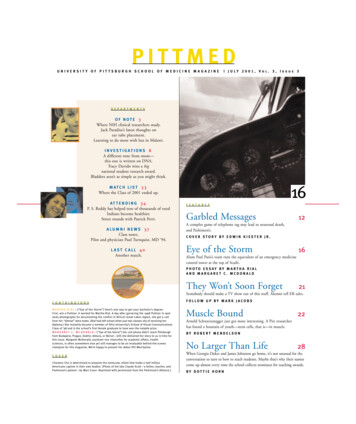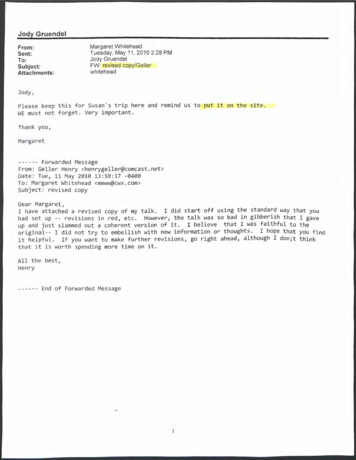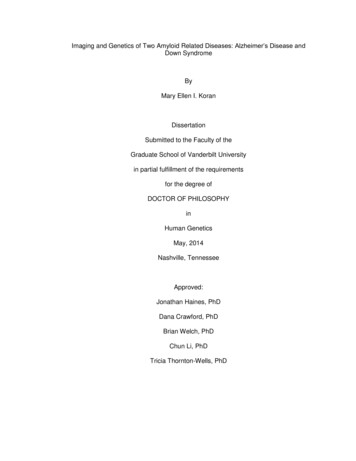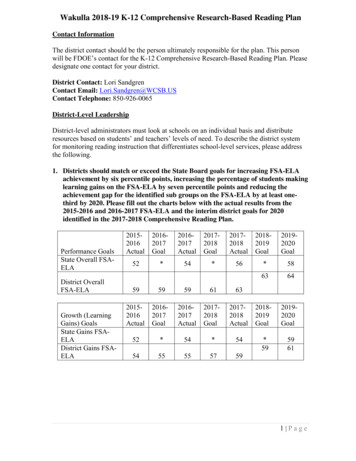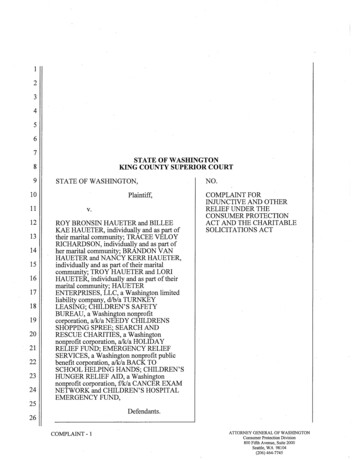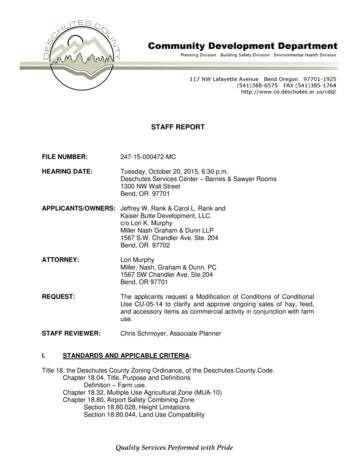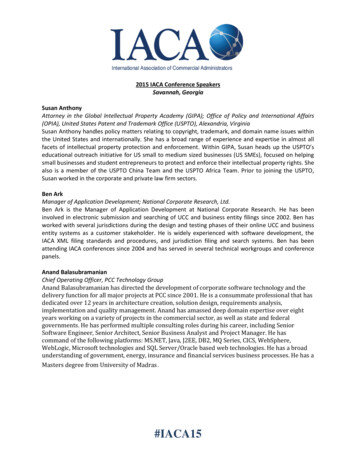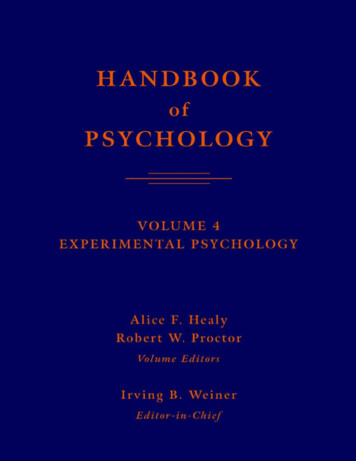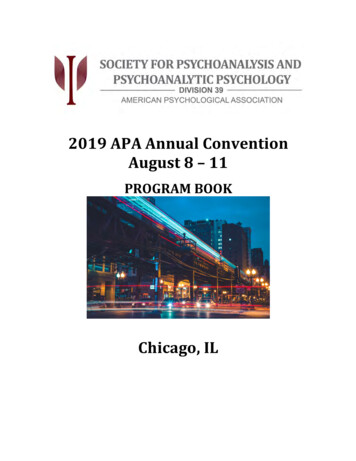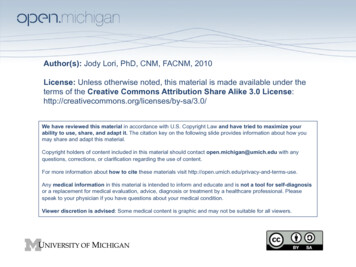
Transcription
Author(s): Jody Lori, PhD, CNM, FACNM, 2010License: Unless otherwise noted, this material is made available under theterms of the Creative Commons Attribution Share Alike 3.0 3.0/We have reviewed this material in accordance with U.S. Copyright Law and have tried to maximize yourability to use, share, and adapt it. The citation key on the following slide provides information about how youmay share and adapt this material.Copyright holders of content included in this material should contact open.michigan@umich.edu with anyquestions, corrections, or clarification regarding the use of content.For more information about how to cite these materials visit http://open.umich.edu/privacy-and-terms-use.Any medical information in this material is intended to inform and educate and is not a tool for self-diagnosisor a replacement for medical evaluation, advice, diagnosis or treatment by a healthcare professional. Pleasespeak to your physician if you have questions about your medical condition.Viewer discretion is advised: Some medical content is graphic and may not be suitable for all viewers.
Citation Keyfor more information see: http://open.umich.edu/wiki/CitationPolicyUse Share Adapt{ Content the copyright holder, author, or law permits you to use, share and adapt. }Public Domain – Government: Works that are produced by the U.S. Government. (17 USC § 105)Public Domain – Expired: Works that are no longer protected due to an expired copyright term.Public Domain – Self Dedicated: Works that a copyright holder has dedicated to the public domain.Creative Commons – Zero WaiverCreative Commons – Attribution LicenseCreative Commons – Attribution Share Alike LicenseCreative Commons – Attribution Noncommercial LicenseCreative Commons – Attribution Noncommercial Share Alike LicenseGNU – Free Documentation LicenseMake Your Own Assessment{ Content Open.Michigan believes can be used, shared, and adapted because it is ineligible for copyright. }Public Domain – Ineligible: Works that are ineligible for copyright protection in the U.S. (17 USC § 102(b)) *laws inyour jurisdiction may differ{ Content Open.Michigan has used under a Fair Use determination. }Fair Use: Use of works that is determined to be Fair consistent with the U.S. Copyright Act. (17 USC § 107) *laws in yourjurisdiction may differOur determination DOES NOT mean that all uses of this 3rd-party content are Fair Uses and we DO NOT guarantee thatyour use of the content is Fair.To use this content you should do your own independent analysis to determine whether or not your use will be Fair.
Cultural Childbirth Practices, Beliefs &Traditions in LiberiaJody R. Lori PhD, CNM, FACNM
Purpose of StudyTo understand the socio-political andcultural context of childbirth in Liberiaincluding practices, beliefs and traditionsthat influence maternal health, illness anddeath.
Research Questions How do Liberian women, familymembers and community membersunderstand and describe maternal illnessand death? What are the political, social and culturalfactors that influence the ways womenseek care during pregnancy andchildbirth?
Maternal Mortality Worldwide 1,400 women die every dayfrom complications related tochildbirth (500,000/year) UN Millennium DevelopmentGoals (MDG) targeted a 75%reduction in maternalmortality by 2015 MDG #5 has made the leastprogress to date (Rosenfield,Maine & Freeman, 2006) 32% of births in sub-SaharanAfrica are attended by askilled attendant (Krug,Prescott & Galea, 2008)
Background Little or no progress has beenmade to improve maternalmortality figures in subSaharan Africa in the past 20years (Lawn et al., 2006) Maternal mortality in subSaharan Africa is nearly 50times higher than inindustrialized countries(Ronsmans & Graham, 2006) Maternal mortality is 1 in 15for a woman in Africacompared to 1 in 3750 for awoman living in NorthAmerica (Abdoulaye, 2006)
The Lancet New modeling Estimated maternal deaths had decreasedfrom 526,000 in 1980 to 343,000 in 2008 Substantial albeit varied progress is beingmade toward MDG 5
Trends in Maternal Mortality Only 10 out of 87countries with MMR over100 in 1990 are on trackto reach MDG5 30 countries madeinsufficient or noprogress since 1990 99% of all maternaldeaths in 2008 occurredin developing regions,with sub-Saharan Africaand South Asiaaccounting for 57% and30% of all deathsrespectively.Please see original image of the cover of “Trends in MaternalMortality: 1990 to 2008” at /monitoring/9789241500265/en/index.html
Maternal Mortality (2008)UNICEF, May, 2008
LiberiaJuan Freire, "Liberia Comunidad pescadores” Post-conflict (2004) 85% unemployment 80% population lives onless 1USD/day One of the fastestgrowing populations insub-Saharan Africa Lack of professionalhealth care providerswww.africaguide.com
Highlights from the LiteratureChildbirth Beliefs & Traditions Women have less personal autonomy, less freedom &less access to information than men (Filippi et al., 2006) How delivery site was determined. Pregnancy viewedas normal; not requiring medical care (Amooti-Kaguna& Nuwaha, 2000) Women lack of responsibility for decision-making –often relegated to older women (Jensen, 2005) Vulnerability during pregnancy from spirits orwitchcraft (Adams et al., 2005; Chapman, 2006;Okafor, 2000)
Theoretical FrameworkGlobal Feminist TheoryVulnerabilityHuman RightsGender-based ViolenceWar Trauma
Global Feminist Theory Woman centered Supports human rights Promotes a reciprocalrelationship between theresearcher & participants Asks how women experienceoppression
Research Design Method Critical Ethnography Unfairness & Injustice Voice of participants Setting Rural Bong County 16 rural health clinics& 1 referral hospital Total population 600,000 Sampling Plan Purposive sampling- basedon participant’s experiences Chain referral- relied onparticipant referral
Data Collection Demographicquestionnaire In-depth semi-structuredinterviews Participant observation Field notes Personal, Methodological,Observational &Theoretical Documents/Artifacts
Data Analysis Iterative process Mentorship of Chair Inductive process The Ethnograph Codewords Codebook Conceptual Categories Major Themes Overarching Theme
Data AnalysisEstablishing Trustworthiness Credibility – prolonged engagement, peer debriefingwith translator/cultural broker & Dissertation Advisor,member checking with participants, multiple datacollection modes Dependability – reflexivity, audit trail, meticulousnotes, expert peer review from Dissertation Advisor Confirmability – journaling, field notes, interview notesand recorded data Transferability – enhanced by thick descriptions, left inthe hands of the consumers of this study
Inclusion Criteria Sample: postpartum women, family members &community members Any postpartum woman who suffered a severe childbirthcomplication Adult men and women who were relatives of a womanwho died during pregnancy or shortly after childbirth orexperienced a severe complication Community members and health care providers withknowledge of the contextual factors in the area of interest Over age 18 years Willing & able to share her experiences Speaks English or Kpelle
Definition of Complications Complications: Hemorrhage leading to shock, emergencyhysterectomy and/or recommended bloodtransfusion Hypertensive disease of pregnancy includingeclampsia and severe pre-eclampsia Dystocia resulting in uterine rupture Infections with fever or a clear source of infectionand clinical signs of shock Severe anemia with hemoglobin levels 6g/dl
Study Context & Participants 54 participants 10 postpartum women with a severe maternalmorbidity 44 family & community members of womensuffering a severe morbidity or maternalmortality (8 cases of maternal mortality)
Participant DemographicsDemographics PostpartumWomen (n 10)MeanRangeAge21.3318-26Education (years completed)30-8Size of household8.73-20Gravidity (number ofpregnancies)2.91-10Number of living children1.80-8Demographics Family &Community Members (n 44)MeanRangeAge45.318-70Education (years completed)7.50-20Size of household8.61-30Source undetermined
Study FindingsBehind The HouseSecrecySurroundingPregnancy &ChildbirthPatterns of CommunicationFemale TraditionsSupernatural ForcesPower &AuthorityDecision-making AuthorityExternal InfluenceVictimization in ChildbirthDistrust ofHealthcareSystemAcceptance of Traditional Healers/MedicineBarriers to Accessing Biomedical CareTrust in CommunityLori, JR & Boyle, JS. Maternal Health, Illness and Death in Post-Conflict Liberia. Health Carefor Women International 32(6): 454-473.
Secrecy SurroundingChildbirth & Pregnancy Female TraditionsBush schools or secret societiesFemale-genital mutilation/ritual cuttings Patterns of Communication“ it is taboo for women to come out and talk about pregnancy anddelivery and menstruation ”Lack of awareness & understanding Supernatural ForcesBelief in witchcraft & magical powersPlanned destiny “Only God solves the problems.”
Power & Authority Decision-Making AuthorityNeed to obtain permission from a male family member to seek careDeference to elders for decision-making “small child” External InfluenceWomen are taught to be obedient and submissive to their husbandsCommunity norms Victimization in ChildbirthIll treatment received in pregnancy & during childbirthInfluenced by low levels of education, poverty, gender & socialclass
Distrust of the Health Care System Acceptance of Traditional Healers/MedicineConfidence & trust in indigenous practitionersUnfamiliar with the hospital environment Barriers to Accessing Biomedical CareStructural – remoteness, money, transportationCognitive – fear, misunderstanding of the hospital Trust in the CommunityComfort in known & familiar surroundingsTrust in traditional practices “The people that live here, they [aretrusted] more than the [clinic] nurses . Mainly they trust thepeople they live with.”
Overarching Theme“When a woman is in labor you take herbehind the house.”
Behind the House Participants did not conceptualize maternal illness anddeath with the same biomedical constructs used inWestern medicine Cultural has a profound influence on childbirth Women experienced reproductive vulnerability becauseof low levels of education, poverty and status within thecommunity Women lacked authority & awareness over theirreproductive health
Behind the House Perceived vulnerability to harm from spirits &witchcraft which contributed to secrecy & precludedwomen from seeking care Gender inequities compromised decision-making Women were exposed to ill-treatment under the rubricof “blaming the victim” Women prioritized social norms over biologicalproblems they experienced
Limitation of the Study Innate power differences & social status Language limited to English & Kpelle Literacy-level
Implications?
Implications - Practice Provides a theory that explains the socio-political and culturalcontext of childbirth in Liberia including practices, beliefs andtraditions that influence maternal health, illness and death Help guide clinical practice Health and human rights are inseparable Providers can incorporate findings into everyday practice byproviding accurate information to women & family members Highlights the importance of cultural sensitivity Move people to action
Conclusions Adds to the literature by providing an additional understanding ofthe socio-political and cultural context of childbirth in Liberiatherefore extending nursing knowledge No reported studies have captured the structural and cognitivebarriers identified in this research by the women, families &community members in post-conflict Liberia Starting point for social transformation
Questions?
Additional Source Informationfor more information see: http://open.umich.edu/wiki/CitationPolicySlide 9, Image 1: Please see original image of the cover of “Trends in Maternal Mortality: 1990 to 2008” at /monitoring/9789241500265/en/index.htmlSlide 11, Image 1: Juan Freire, "Liberia Comunidad pescadores", flickr, http://www.flickr.com/photos/jfreire/3350521326/, CC: BY2.0, http://creativecommons.org/licenses/by/2.0/.Slide 23, Image 1: Lori, JR & Boyle, JS. Maternal Health, Illness and Death in Post-Conflict Liberia. Health Care for WomenInternational 32(6): 454-473.
Childbirth Power & Authority Distrust of Healthcare System Behind The House Decision-making Authority External Influence Victimization in Childbirth Patterns of Communication Female Traditions Supernatural Forces Acceptance of Traditional Healers/Medicine Barriers to Accessing Biomedical Care Tr
